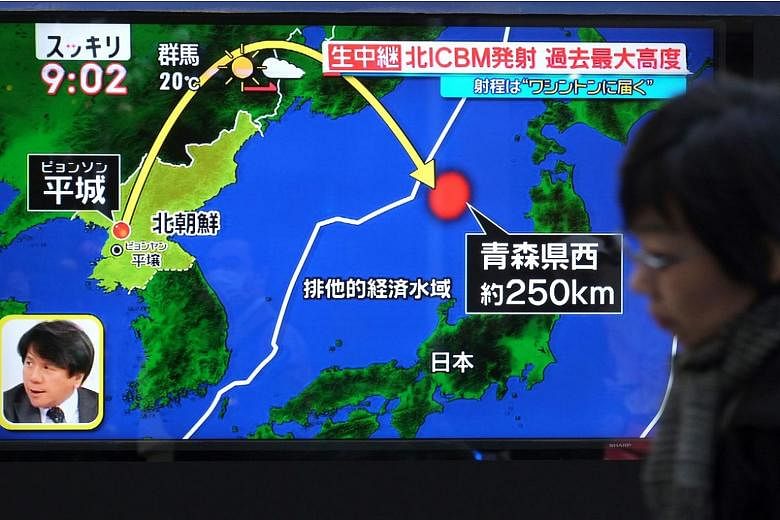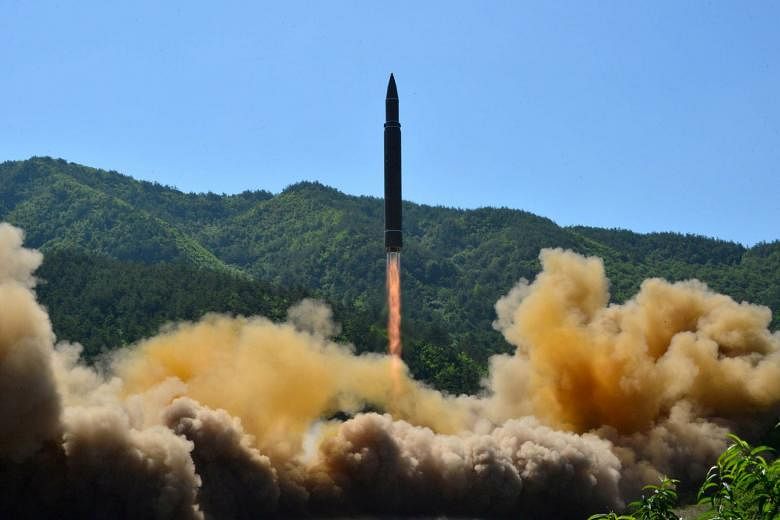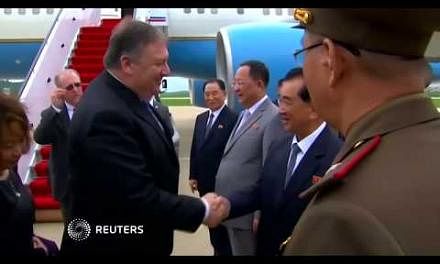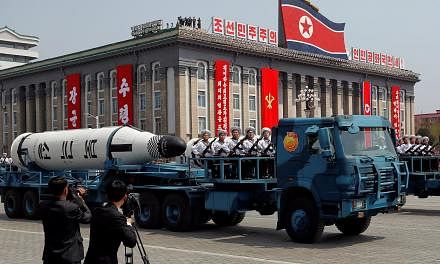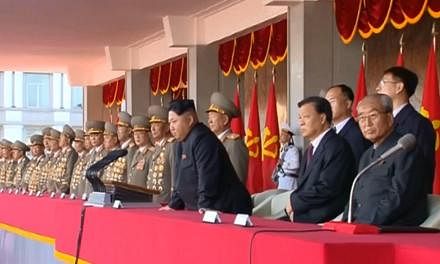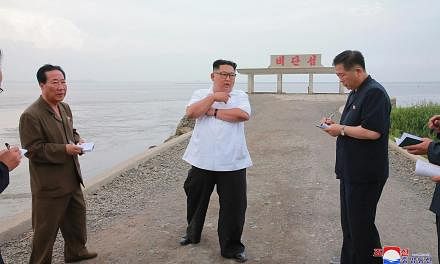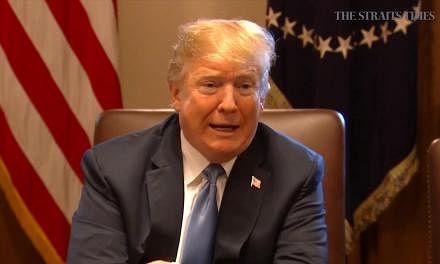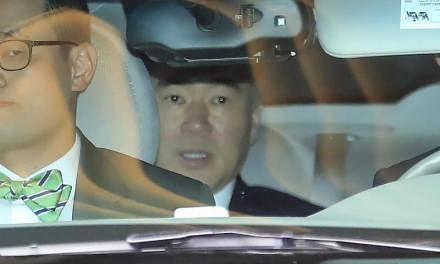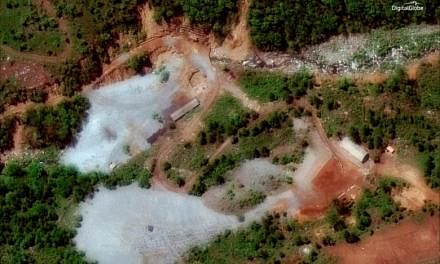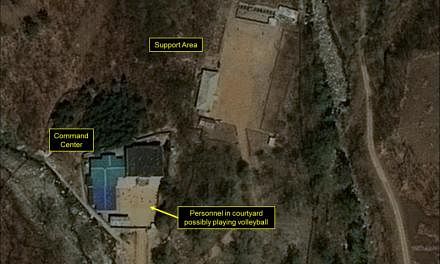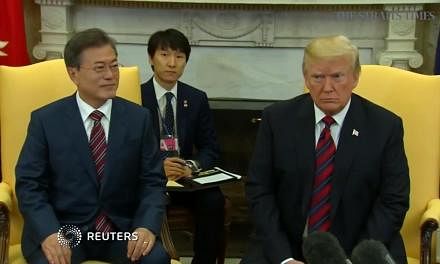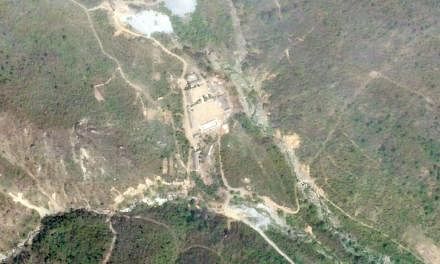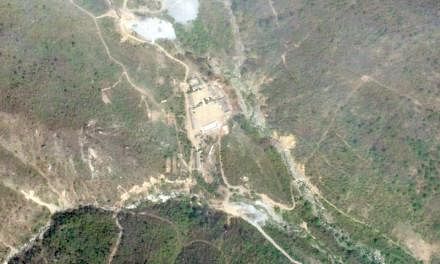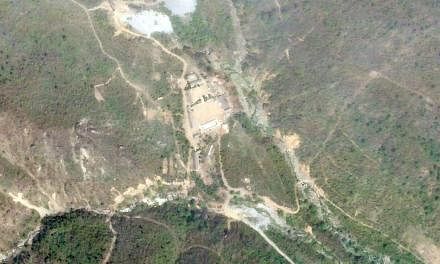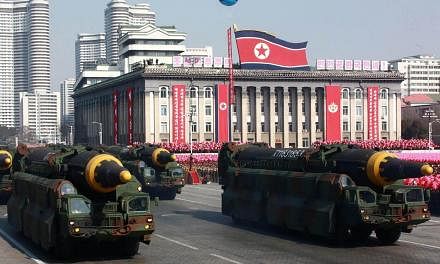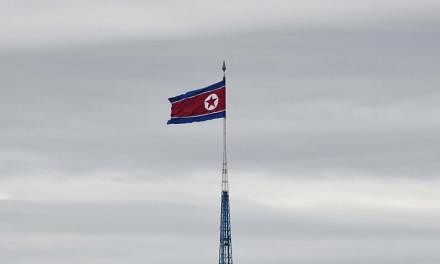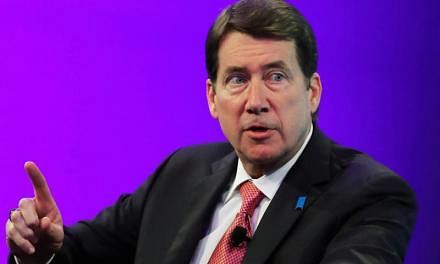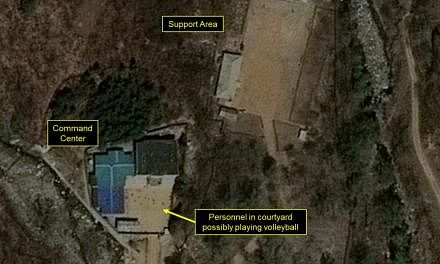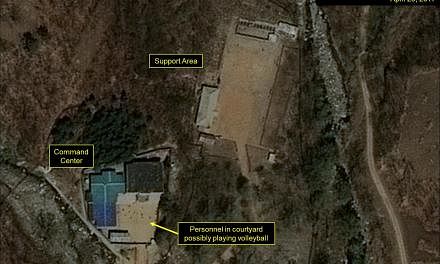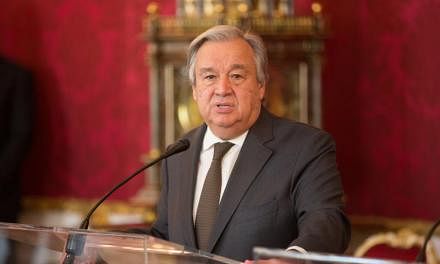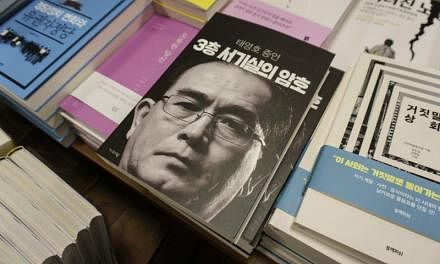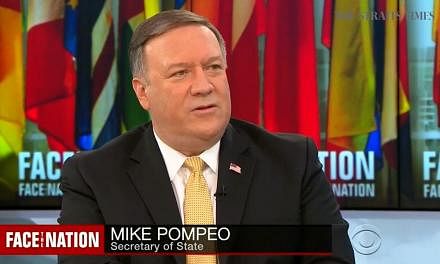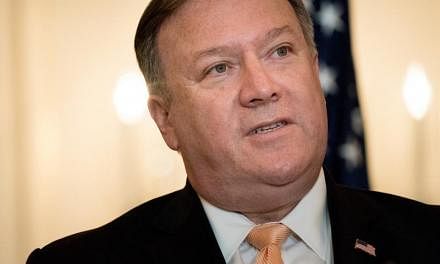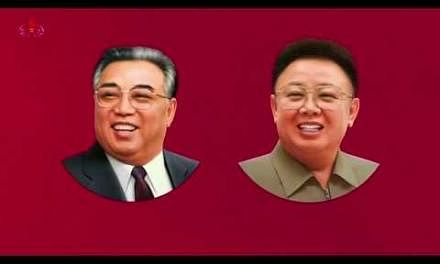WASHINGTON/SEOUL/TOKYO (NYTIMES, REUTERS, AFP) - North Korea successfully launched a new type of intercontinental ballistic missile, the Hwasong-15, that can reach all of the United States mainland, the isolated country's state media said on Wednesday (Nov 29).
In a broadcast on state TV, North Korea said the new powerful missile reached an altitude of around 4,475km (2,780 miles) - more than 10 times the height of the international space station - and flew 950km (600 miles) during its 53-minute flight.
After watching the successful launch of the new type ICBM Hwasong-15, the North's leader Kim Jong Un declared with pride that "now we have finally realised the great historic cause of completing the state nuclear force, the cause of building a rocket power", according to a statement read by a television presenter.
The missile test, North Korea's first since mid-September, came a week after US President Donald Trump put North Korea back on a US list of countries that Washington says support terrorism. The designation allows the US to impose more sanctions, although some experts said it risked inflaming tensions on the Korean Peninsula.
North Korea has conducted dozens of ballistic missile tests under Kim in defiance of international sanctions. Trump has vowed not to let North Korea develop nuclear missiles that can hit the mainland US.
In the statement on Wednesday, North Korea described itself as a "responsible nuclear power", but warned its strategic weapons were developed to defend its sovereignty and territorial integrity from "the US imperialists' nuclear blackmail policy and nuclear threat".
US, Japanese and South Korean officials all agreed the missile, which landed within Japan's exclusive economic zone in the Sea of Japan, was likely an ICBM but it did not pose a threat to the US, its territories or allies, the Pentagon said.
'Threaten everywhere'
"It went higher frankly than any previous shot they've taken, a research and development effort on their part to continue building ballistic missiles that can threaten everywhere in the world, basically," US Defence Secretary James Mattis told reporters at the White House.
Trump spoke by phone with Japanese Prime Minister Shinzo Abe and South Korean President Moon Jae In, with all three leaders reaffirming their commitment to combat the North Korean threat.
"It is a situation that we will handle," Trump told reporters.
Moon told Trump that North Korea's missile technology seemed to have improved, a spokesman for the South Korean leader's office said. Trump, who was briefed on the missile while it was in flight, said it did not change his administration's approach to North Korea, which has included new curbs to hurt trade between China and North Korea.
All Options
Washington has said repeatedly that all options, including military ones, are on the table in dealing with North Korea.
"Diplomatic options remain viable and open, for now," US Secretary of State Rex Tillerson said. Other than carrying out existing UN sanctions, "the international community must take additional measures to enhance maritime security, including the right to interdict maritime traffic" travelling to North Korea, Tillerson said in a statement.
Many nuclear experts say the North has yet to prove it has mastered all technical hurdles including the ability to deliver a nuclear warhead reliably atop an ICBM, but likely soon will.
"We don't have to like it, but we're going to have to learn to live with North Korea's ability to target the United States with nuclear weapons," said Jeffrey Lewis, head of the East Asia Nonproliferation Programme at the Middlebury Institute of Strategic Studies.
'Violent act'
Japan's defence minister Itsunori Onodera told reporters the authorities had not received any reports of damage to airplanes or vessels operating near the area where the missile crashed into the sea, adding that the missile was fired "at a lofted trajectory".
A North Korean missile on Aug 29 was airborne for 14 minutes over Japan.
Japanese Prime Minister Shinzo Abe said Tokyo was requesting an emergency meeting of the United Nations Security Council.
"We can never accept this violent act and have strongly protested to North Korea," Abe told reporters. He called on all countries to strictly implement sanctions against Pyongyang.

Speaking later in parliament, Abe said he had reaffirmed the importance of China in the crisis during a call with US President Donald Trump and praised Beijing for upholding sanctions on North Korea.
"The government welcomes the fact that China is taking concrete steps such as an embargo on imports of North Korea's coal, marine products, textile products, among others," Abe told a parliamentary committee.
"Frankly speaking, I feel that China is playing its role" over the UN-agreed sanctions, he said.
China, North Korea's lone major ally, expressed "grave concern" at the test, while calling for all sides to act cautiously.
The UN Security Council was scheduled to meet on Wednesday to discuss the launch, which Secretary-General Antonio Guterres strongly condemned. "This is a clear violation of Security Council resolutions and shows complete disregard for the united view of the international community," his spokesman said in a statement.
US East Coast in range?
The new Hwasong-15, named after the planet Mars, was a more advanced version of an ICBM tested twice in July, North Korea said. It was designed to carry a "super-large heavy warhead".
Based on its trajectory and distance, the missile would have a range of more than 13,000km - more than enough to reach Washington D.C. and the rest of the United States, the US-based Union of Concerned Scientists said.
However, it was unclear how heavy a payload the missile was carrying, and it was uncertain if it could carry a large nuclear warhead that far, the nonprofit science advocacy group added.
Minutes after the North fired the missile, South Korea's military said it conducted a missile-firing test in response. President Moon said the launch had been anticipated. There was no choice but for countries to keep applying pressure, he added.
"The situation could get out of control if North Korea perfects its ICBM technology," Moon said after a national security council meeting. "North Korea shouldn't miscalculate the situation and threaten South Korea with a nuclear weapon, which could elicit a possible pre-emptive strike by the United States."
US stocks briefly pared gains on the news but the S&P 500 index was up almost 1 per cent at the close.
Two US government sources said earlier that US government experts believed North Korea could conduct a new missile test within days.
After firing missiles at a rate of about two or three a month since April, North Korea paused its missile launches in September, after it fired a missile that passed over Japan's northern Hokkaido island on Sept 15.
The US officials who spoke earlier declined to say what type of missile they thought North Korea might test.
Nuclear deterrent
Last week, North Korea denounced Trump's decision to relist it as a state sponsor of terrorism, calling it a "serious provocation and violent infringement".
Trump has traded insults and threats with North Korean leader Kim Jong Un and warned in his maiden speech to the United Nations in September that the US would have no choice but to "totally destroy" North Korea if forced to defend itself or its allies.
Washington has said repeatedly that all options are on the table in dealing with North Korea, including military ones, but that it prefers a peaceful solution by Pyongyang agreeing to give up its nuclear and missile programmes.
To this end, Trump has pursued a policy of encouraging countries around the world, including North Korea's main ally and neighbour, China, to step up sanctions on Pyongyang to persuade it to give up its weapons programmes.
North Korea has given no indication it is willing to re-enter diplomatic talks on those terms.
North Korea has said its weapons programme is a necessary defence against US plans to invade. The US, which has 28,500 troops in South Korea as a legacy of the 1950-53 Korean war, denies any such intention.
Harry Kazianis, director of defence studies at Washington's conservative Centre for the National Interest, said he thought North Korea might hold off on missile testing until about the time of the Winter Olympics, which South Korea is hosting next February, but added that North Korea had to keep testing to refine its weapons programme.
"I am surprised, but not shocked," he said. "North Korea tested two missiles in the fourth quarter last year and will have to continue to test its missile capabilities for years to come if it wants a nuclear deterrent that can hit the US."
